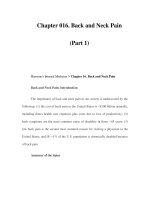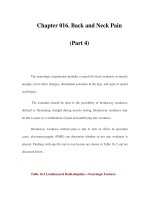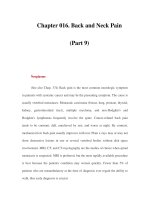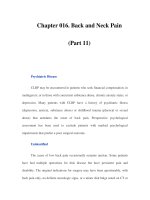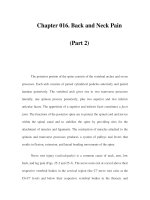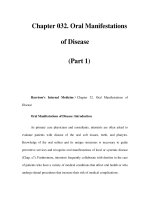Chapter 073. Enteral and Parenteral Nutrition (Part 1) doc
Bạn đang xem bản rút gọn của tài liệu. Xem và tải ngay bản đầy đủ của tài liệu tại đây (56.13 KB, 5 trang )
Chapter 073. Enteral and
Parenteral Nutrition
(Part 1)
Harrison's Internal Medicine > Part 4. Nutrition > Chapter 73. Enteral
and Parenteral Nutrition Therapy
Enteral and Parenteral Nutrition Therapy: Introduction
The ability to provide specialized nutritional support (SNS) represents a
major advance in medical therapy. Nutritional support, via either enteral or
parenteral routes, is used in two main settings: (1) to provide adequate nutritional
intake during the recuperative phase of illness or injury, when the patient's ability
to ingest or absorb nutrients is impaired, and (2) to support the patient during the
systemic response to inflammation, injury, or infection during an extended critical
illness.
SNS is also used in patients with permanent loss of intestinal length or
function. In addition, an increasing number of elderly patients living in nursing
homes and chronic care facilities receive enteral feeding, usually as a consequence
of inadequate nutritional intake.
Enteral refers to feeding via a tube placed into the gut to deliver liquid
formulas containing all essential nutrients. Parenteral refers to the infusion of
complete nutrient solutions into the bloodstream via a peripheral vein or, more
commonly, by central venous access to meet nutritional needs.
Enteral feeding is generally the preferred route because of benefits derived
from maintaining the digestive, absorptive, and immunologic barrier functions of
the gastrointestinal tract. Small-bore pliable tubes have largely replaced large-bore
rubber tubes, making placement easier and more acceptable to patients. Infusion
pumps have also improved the delivery of nutrient solutions.
For short-term use, enteral tubes can be placed via the nose into the
stomach, duodenum, or jejunum. For long-term use, these sites can be accessed
through the abdominal wall using endoscopic, radiologic, or surgical procedures.
Intestinal tolerance of tube feeding may be limited during acute illness by gastric
retention or diarrhea. Parenteral feeding has greater risk of infection, reflecting the
need for venous access, and a greater propensity for inducing hyperglycemia.
However, these risks can generally be managed successfully by SNS teams. For
the postoperative patient with preexisting malnutrition, or in trauma patients who
were previously well nourished, SNS is strikingly cost-effective. In the most
critically ill patient in the intensive care unit, SNS can dramatically enhance
survival. Although enteral nutrition (EN) can be provided by most health care
teams caring for hospitalized patients, safe and effective parenteral nutrition (PN)
usually requires specialized teams.
Approach to the Patient: Requirements for Specialized Nutritional
Support
Indications for Specialized Nutritional Support
Although at least 15–20% of patients in acute care hospitals have evidence
of significant malnutrition, only a small fraction will benefit from SNS. For others,
wasting is an inevitable component of a terminal disease and the course of the
disease will not be altered by SNS.
The decision to use SNS should be based on the likelihood that preventing
protein-calorie malnutrition (PCM) will increase the likelihood of recovery, reduce
infection rates, improve healing, or otherwise shorten the hospital stay.
In the case of the elderly or chronically ill patient for whom full recovery is
not anticipated, the decision to feed is usually based on whether SNS will extend
the duration and quality of life. The decision-making process used to decide when
to use SNS is depicted in Fig. 73-1.
Figure 73-1
